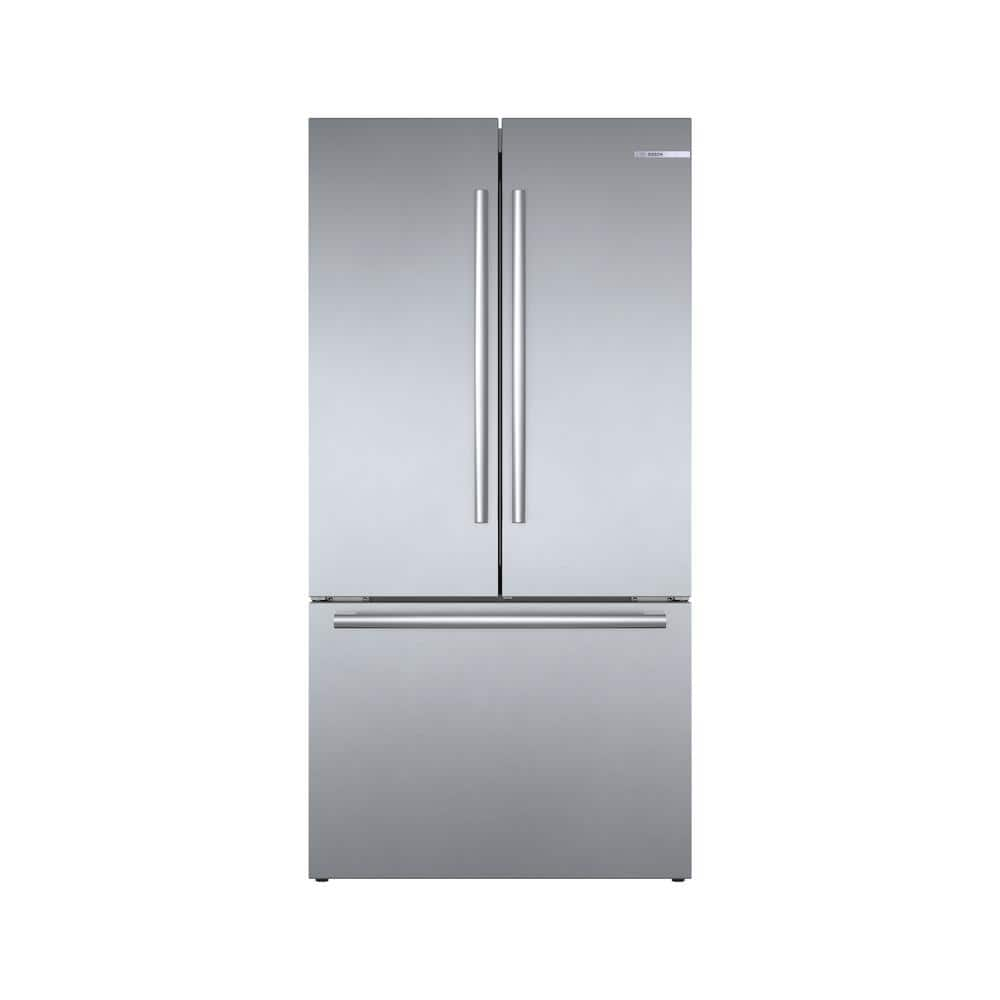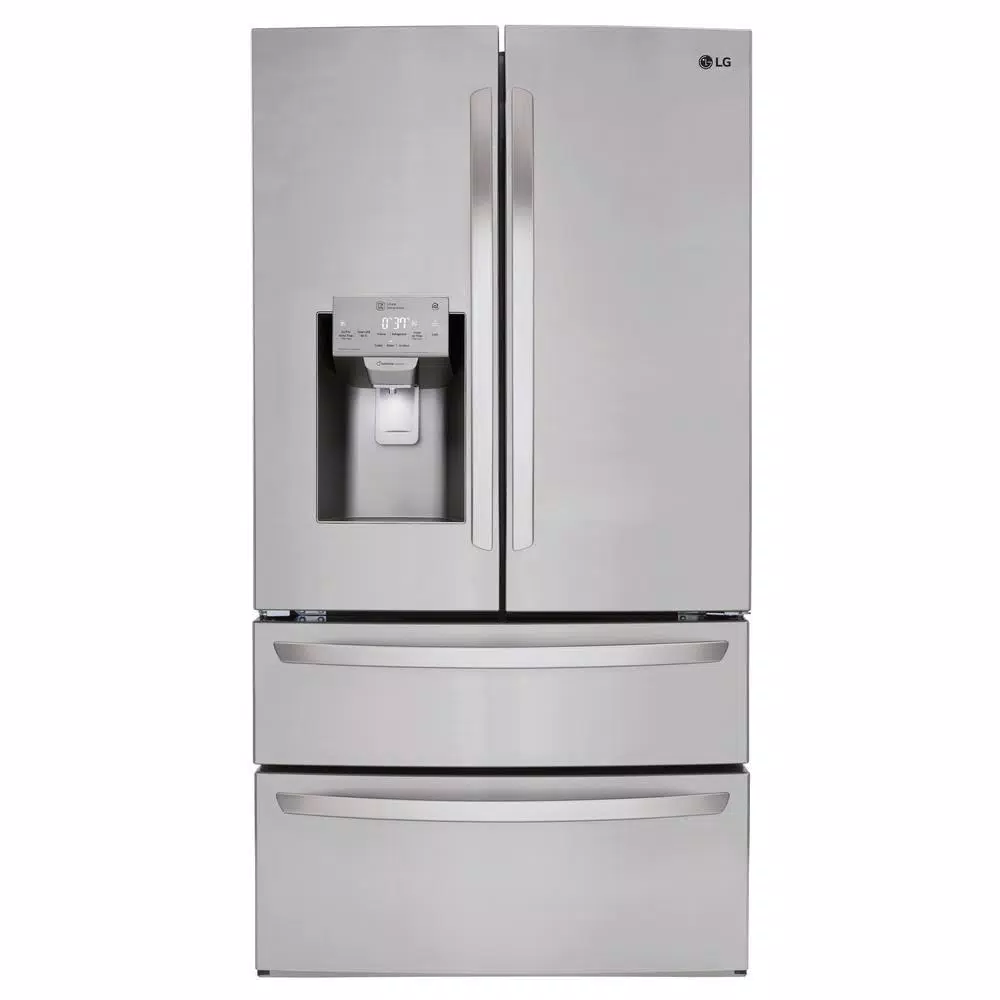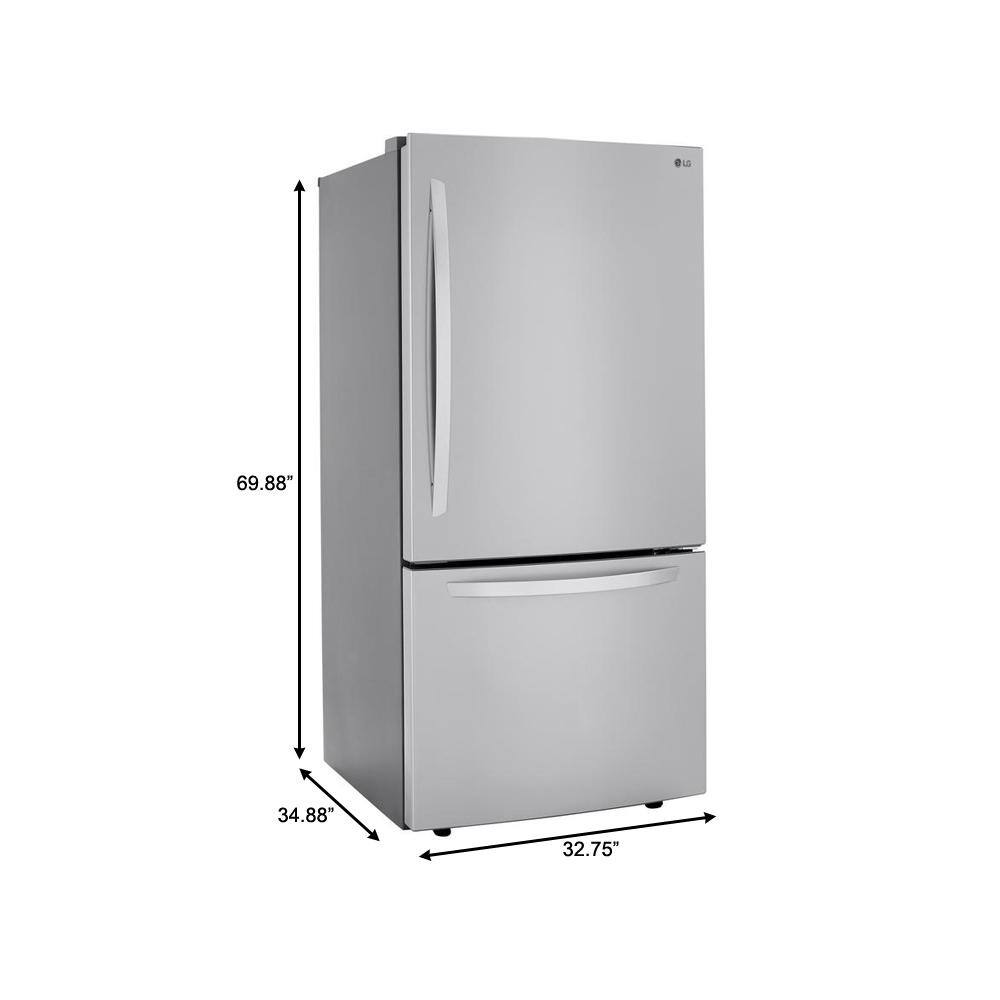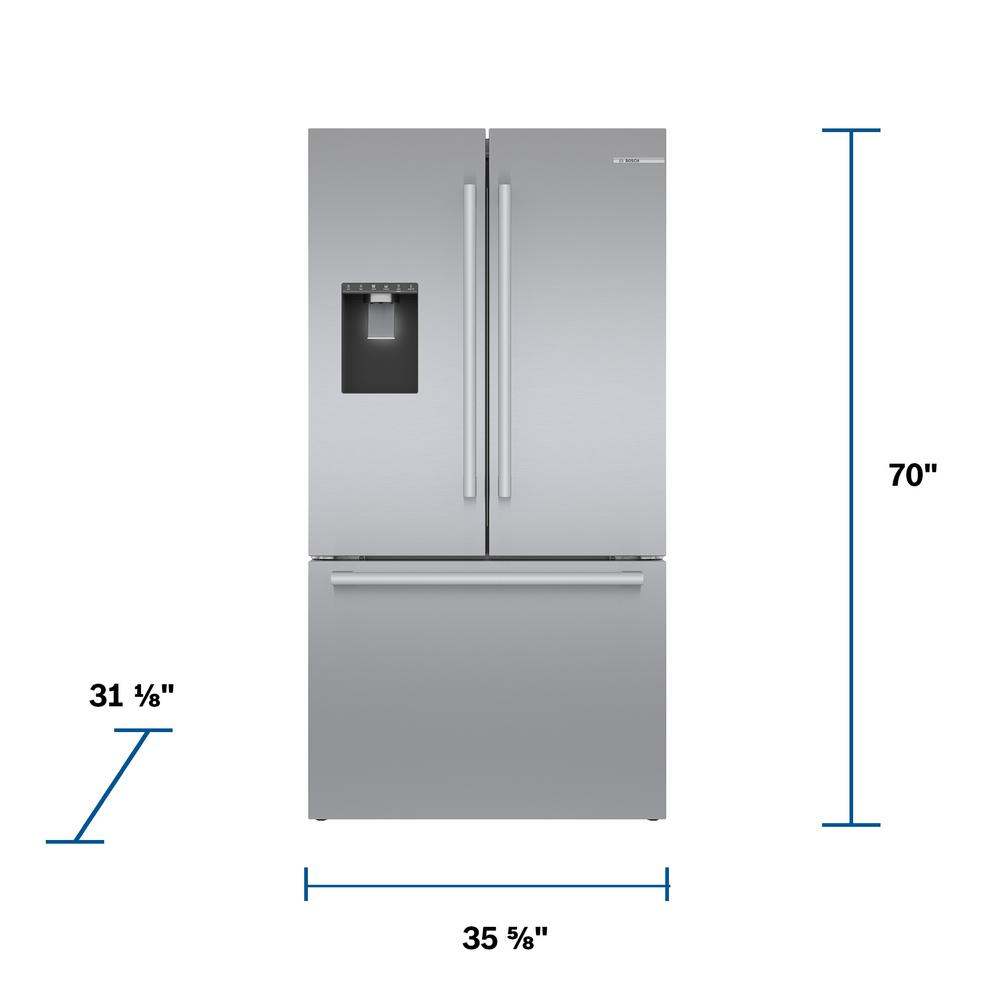Bosch 800 Series 36 in. 21 cu. ft. French 3 Door Refrigerator in Stainless Steel with Dual Compressor, Counter-Depth
FarmFresh System™ is to keep your food fresher, longer. FlexBar™ organizes your fridge in ways never done before. Drip-free interior water dispenser provides a streamlined design.
Introducing the revolutionary, Bosch counter-depth refrigerators, with a streamlined interior and advanced freshness system designed to keep the ingredients you love fresher longer. Enjoy less food waste, and more thoughtful design. Our revolutionary FarmFresh System combines four innovative technologies designed to take food preservation to the next level, while minimizing food waste. Working in harmony, the (1) VitaFreshPro, (2) FreshProtect Ethylene Filter, (3) MultiAirFlow, and (4) AirFresh Filter provide the optimal environment for your food storage needs. An industry first, VitaFreshPro automatically balances both temperature and humidity. From produce to meats to cheeses, pre-programmed settings calibrate the optimal environment, removing the guesswork from food storage. FreshProtect absorbs naturally occurring ethylene to slow ripening, so produce stays fresher, longer. MultiAirFlow and AirFreshFilter work together to keep the temperature in your entire fridge consistent while reducing odors. Its refrigeration, reinvented.
- ENERGY STAR Qualified for year round energy and money savings
- A generous 21 cu. ft. capacity is made even more spacious with flexible storage features like the industry first FlexBar, and removable shelves and door bins
- Thoughtfully tucked away is the internal water dispenser for refreshing, pure water at the touch of a button, or push of a nozzle, without disrupting the exterior design in
- The advanced ice maker creates pyramid-shaped ice straight from your freezer, Fully accessible via a pull-out bin and ice scoop
- Experience crisp, beautiful LED illumination from corner to corner
- This freestanding refrigerator sits flush with the countertop, features hidden hinges, and discreet tucked away feet, all to give you a true built-in look and feel
- The revolutionary FarmFresh System combines four innovative technologies designed to take food preservation to the next level, while minimizing food waste
- FarmFresh System keeps your food fresh up to 3x longer, for less food wasted.* — *As compared to a Bosch refrigerator without FarmFresh System. Results may vary among different foods*
- Store oversized platters with ease until youre ready to serve them, or store snacks for quick access and easy visibility
- Keep your kitchen looking beautiful with an easy to clean stainless steel exterior
- Home Connect lets you easily manage your Bosch refrigerator from the convenience of your smartphone or tablet
- Premium and modern touch control display is strategically placed for easy accessibility, and allows you to control the features of your refrigerator with the touch of a button
- Dual compressors and evaporators offer precise cooling and humidity control, while reducing odor transfer
Additional information
| Depth (Excluding Handles) (in.) | 28.625 |
|---|---|
| Depth (Including Handles) (in.) | 30.91 |
| Depth (Less Door) (in.) | 24 |
| Depth With Door Open 90 Degrees (In) | 43.38 |
| Height to Top of Door Hinge (in.) | 72 |
| Height to Top of Refrigerator (in.) | 71.50 |
| Product Depth x Height x Width (in.) | 28.5 x 72 x 35.625 |
| Refrigerator Width (In.) | 35.625 |
| Certifications and Listings | CSA Listed,Energy Star,UL Listed |
| Manufacturer Warranty | 1 Year Limited |
Twenty-one, XXI or 21 may refer to:
- 21 (number), the natural number following 20 and preceding 22
- The years 21 BC, AD 21, 1921, 2021
3 (three) is a number, numeral and digit. It is the natural number following 2 and preceding 4, and is the smallest odd prime number and the only prime preceding a square number. It has religious and cultural significance in many societies.
36 may refer to:
- 36 (number), the natural number following 35 and preceding 37
- 36 BC, 1st century BCE
- AD 36, 1st century
- 1936, 20th century
- 2036, 21st century
Year 800 (DCCC) was a leap year starting on Wednesday (link will display the full calendar) of the Julian calendar, the 800th year of the Common Era (CE) and Anno Domini (AD) designations, the 800th year of the 1st millennium, the 100th and last year of the 8th century, and the 1st year of the 800s decade. It was around this time that the Anno Domini calendar era became the prevalent method in Europe for naming years, so from this time on, the years began to be known as 800 and onwards.
A compressor is a mechanical device that increases the pressure of a gas by reducing its volume. An air compressor is a specific type of gas compressor.
Compressors are similar to pumps: both increase the pressure on a fluid and both can transport the fluid through a pipe. The main distinction is that the focus of a compressor is to change the density or volume of the fluid, which is mostly only achievable on gases. Gases are compressible, while liquids are relatively incompressible, so compressors are rarely used for liquids. The main action of a pump is to pressurize and transport liquids.
Many compressors can be staged, that is, the fluid is compressed several times in steps or stages, to increase discharge pressure. Often, the second stage is physically smaller than the primary stage, to accommodate the already compressed gas without reducing its pressure. Each stage further compresses the gas and increases its pressure and also temperature (if inter cooling between stages is not used).
A door is a hinged or otherwise movable barrier that allows ingress (entry) into and egress (exit) from an enclosure. The created opening in the wall is a doorway or portal. A door's essential and primary purpose is to provide security by controlling access to the doorway (portal). Conventionally, it is a panel that fits into the doorway of a building, room, or vehicle. Doors are generally made of a material suited to the door's task. They are commonly attached by hinges, but can move by other means, such as slides or counterbalancing.
The door may be able to move in various ways (at angles away from the doorway/portal, by sliding on a plane parallel to the frame, by folding in angles on a parallel plane, or by spinning along an axis at the center of the frame) to allow or prevent ingress or egress. In most cases, a door's interior matches its exterior side. But in other cases (e.g., a vehicle door) the two sides are radically different.
Many doors incorporate locking mechanisms to ensure that only some people can open them (such as with a key). Doors may have devices such as knockers or doorbells by which people outside announce their presence. (In some countries, such as Brazil, it is customary to clap from the sidewalk to announce one's presence.) Apart from providing access into and out of a space, doors may have the secondary functions of ensuring privacy by preventing unwanted attention from outsiders, of separating areas with different functions, of allowing light to pass into and out of a space, of controlling ventilation or air drafts so that interiors may be more effectively heated or cooled, of dampening noise, and of blocking the spread of fire.
Doors can have aesthetic, symbolic, ritualistic purposes. Receiving the key to a door can signify a change in status from outsider to insider. Doors and doorways frequently appear in literature and the arts with metaphorical or allegorical import as a portent of change.
French may refer to:
- Something of, from, or related to France
- French language, which originated in France
- French people, a nation and ethnic group
- French cuisine, cooking traditions and practices
A refrigerator, colloquially fridge, is a commercial and home appliance consisting of a thermally insulated compartment and a heat pump (mechanical, electronic or chemical) that transfers heat from its inside to its external environment so that its inside is cooled to a temperature below the room temperature. Refrigeration is an essential food storage technique around the world. The low temperature lowers the reproduction rate of bacteria, so the refrigerator reduces the rate of spoilage. A refrigerator maintains a temperature a few degrees above the freezing point of water. The optimal temperature range for perishable food storage is 3 to 5 °C (37 to 41 °F). A similar device that maintains a temperature below the freezing point of water is called a freezer. The refrigerator replaced the icebox, which had been a common household appliance for almost a century and a half. The United States Food and Drug Administration recommends that the refrigerator be kept at or below 4 °C (40 °F) and that the freezer be regulated at −18 °C (0 °F).
The first cooling systems for food involved ice. Artificial refrigeration began in the mid-1750s, and developed in the early 1800s. In 1834, the first working vapor-compression refrigeration, using the same technology seen in air conditioners, system was built. The first commercial ice-making machine was invented in 1854. In 1913, refrigerators for home use were invented. In 1923 Frigidaire introduced the first self-contained unit. The introduction of Freon in the 1920s expanded the refrigerator market during the 1930s. Home freezers as separate compartments (larger than necessary just for ice cubes) were introduced in 1940. Frozen foods, previously a luxury item, became commonplace.
Freezer units are used in households as well as in industry and commerce. Commercial refrigerator and freezer units were in use for almost 40 years prior to the common home models. The freezer-over-refrigerator style had been the basic style since the 1940s, until modern, side-by-side refrigerators broke the trend. A vapor compression cycle is used in most household refrigerators, refrigerator–freezers and freezers. Newer refrigerators may include automatic defrosting, chilled water, and ice from a dispenser in the door.
Domestic refrigerators and freezers for food storage are made in a range of sizes. Among the smallest are Peltier-type refrigerators designed to chill beverages. A large domestic refrigerator stands as tall as a person and may be about one metre (3 ft 3 in) wide with a capacity of 0.6 m3 (21 cu ft). Refrigerators and freezers may be free standing, or built into a kitchen. The refrigerator allows the modern household to keep food fresh for longer than before. Freezers allow people to buy perishable food in bulk and eat it at leisure, and make bulk purchases.
Stainless may refer to:
- Cleanliness, or the quality of being clean
- Stainless steel, a corrosion-resistant metal alloy
- Stainless Games, a British video game developer
- Stainless Broadcasting Company, a TV broadcaster based in Michigan, US
- Stainless Banner, the second national flag of the Confederate States of America
Steel is an alloy of iron and carbon with improved strength and fracture resistance compared to other forms of iron. Because of its high tensile strength and low cost, steel is one of the most commonly manufactured materials in the world. Steel is used in buildings, as concrete reinforcing rods, in bridges, infrastructure, tools, ships, trains, cars, bicycles, machines, electrical appliances, furniture, and weapons.
Iron is always the main element in steel, but many other elements may be present or added. Stainless steels, which are resistant to corrosion and oxidation, typically need an additional 11% chromium.
Iron is the base metal of steel. Depending on the temperature, it can take two crystalline forms (allotropic forms): body-centred cubic and face-centred cubic. The interaction of the allotropes of iron with the alloying elements, primarily carbon, gives steel and cast iron their range of unique properties. In pure iron, the crystal structure has relatively little resistance to the iron atoms slipping past one another, and so pure iron is quite ductile, or soft and easily formed. In steel, small amounts of carbon, other elements, and inclusions within the iron act as hardening agents that prevent the movement of dislocations.
The carbon in typical steel alloys may contribute up to 2.14% of its weight. Varying the amount of carbon and many other alloying elements, as well as controlling their chemical and physical makeup in the final steel (either as solute elements, or as precipitated phases), impedes the movement of the dislocations that make pure iron ductile, and thus controls and enhances its qualities. These qualities include the hardness, quenching behaviour, need for annealing, tempering behaviour, yield strength, and tensile strength of the resulting steel. The increase in steel's strength compared to pure iron is possible only by reducing iron's ductility.
Steel was produced in bloomery furnaces for thousands of years, but its large-scale, industrial use began only after more efficient production methods were devised in the 17th century, with the introduction of the blast furnace and production of crucible steel. This was followed by the Bessemer process in England in the mid-19th century, and then by the open-hearth furnace. With the invention of the Bessemer process, a new era of mass-produced steel began. Mild steel replaced wrought iron. The German states were the major steel producers in Europe in the 19th century. American steel production was centered in Pittsburgh, Bethlehem, Pennsylvania, and Cleveland until the late 20th century.
Further refinements in the process, such as basic oxygen steelmaking (BOS), largely replaced earlier methods by further lowering the cost of production and increasing the quality of the final product. Today more than 1.6 billion tons of steel is produced annually. Modern steel is generally identified by various grades defined by assorted standards organizations. The modern steel industry is one of the largest manufacturing industries in the world, but also one of the most energy and greenhouse gas emission intense industries, contributing 8% of global emissions. However, steel is also very reusable: it is one of the world's most-recycled materials, with a recycling rate of over 60% globally.
With or WITH may refer to:
- With, a preposition in English
- Carl Johannes With (1877–1923), Danish doctor and arachnologist
- With (character), a character in D. N. Angel
- With (novel), a novel by Donald Harrington
- With (album), a 2014 album by TVXQ
- With (EP), a 2021 EP by Nam Woo-hyun






by Andrew
We have been very happy. Seems to stay at temperature consistently. Vegetables and fruits seem to last longer than our previous refrigerators we have owned.
by Joe
Great product love the water on the inside, no more water and ice stains on the freg.
by Taco
This has been excellent so far. Ice maker is great, looks great, quiet and keeps things cold.
by Alejandro
This fridge is great. keeps food and perisheble items from getting spoiled. The ice drawer is huge and makes ice fast. The freezer drawers are very easy to fill and maneuver.
by Greg
The unit works well and is perfect for our needs. However, it is a counter depth refrigerator so it is narrower. However, for two people and two dogs it’s great!
by Donna
Sleek, beautiful, and it works! Beautiful ice and compartments that are adjustable. Great price compared to other high end fridges with the interior stainless steel design.
by Whitney
Such a great fridge. Plenty of storage- especially in the freezer. Can’t recommend enough!